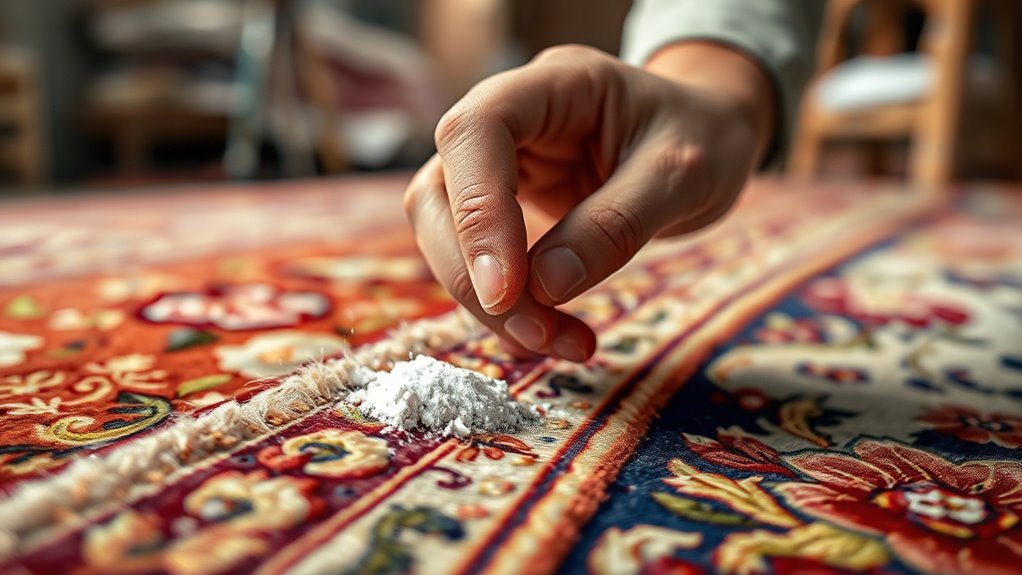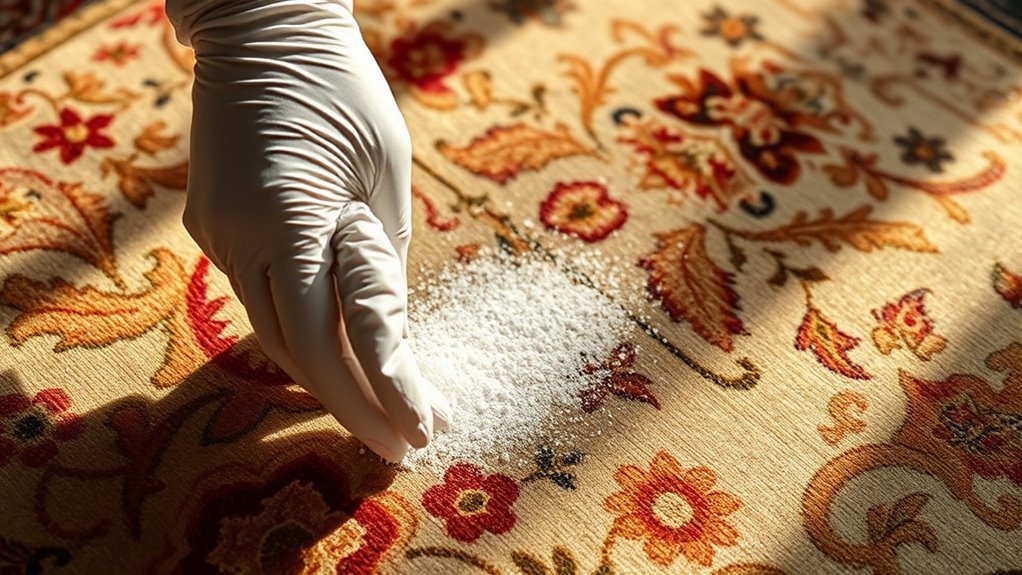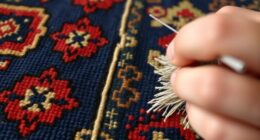To responsibly mothproof your silk carpets, focus on natural methods like cedarwood or lavender sachets, which repel moths without chemicals. Regular vacuuming, proper storage in breathable covers, and maintaining low humidity help prevent infestations. Inspect your carpets frequently for signs of moth activity and keep the environment clean and well-ventilated. Incorporating eco-friendly pest deterrents can protect your silk while preserving its delicate fibers; discover more effective strategies below.
Key Takeaways
- Use natural repellents like cedarwood or lavender sachets to deter moths without chemicals.
- Regularly vacuum and clean carpets to remove eggs, larvae, and debris that attract moths.
- Store silk carpets in breathable, moth-resistant covers infused with natural oils, in cool, dry locations.
- Conduct routine inspections for signs of infestation, such as tiny holes or webbing, for early detection.
- Incorporate eco-friendly methods like dried herbs and proper ventilation to protect silk fibers responsibly.
Understanding the Needs of Silk Carpets and Moth Prevention

Silk carpets are delicate and luxurious, making them particularly vulnerable to moth damage. Understanding silk fiber properties helps you recognize why moths target them. Silk is a natural protein fiber, soft yet strong, but its organic composition makes it appealing to moths at various stages of their lifecycle. The moth lifecycle, which includes eggs, larvae, pupae, and adults, plays a pivotal role in infestation risks. Moth larvae are especially destructive, feeding on the protein-rich silk. Knowing this, you realize that preventing moths from reaching the larvae is essential. Proper storage, regular inspection, and maintaining a clean environment disrupt the moth lifecycle, reducing the risk of damage. Additionally, advances in AI-powered detection technologies are now being used to identify early signs of infestations more effectively. Protecting your silk carpet requires awareness of these unique vulnerabilities and proactive prevention.
Natural and Eco-Friendly Mothproofing Techniques

To protect your silk carpet from moth damage without relying on harsh chemicals, consider natural and eco-friendly techniques. Unlike chemical treatments and synthetic repellents, these methods are safe for both your carpet and the environment. Here are three effective options:
Protect your silk carpet naturally with eco-friendly moth repellents like cedarwood, lavender, and regular vacuuming.
- Use cedarwood or lavender sachets, which naturally repel moths without harmful chemicals.
- Regularly vacuum your carpet to remove larvae and eggs, reducing the need for chemical treatments.
- Store your silk carpets in breathable cotton covers infused with natural oils like cedar or lavender for ongoing moth deterrence.
- Incorporating traditional Italian aromatics such as dried herbs can also serve as a natural moth repellent and add a pleasant scent to storage areas.
These eco-friendly approaches prevent moth infestations while maintaining the integrity of your silk fibers, ensuring responsible and sustainable protection.
Preventive Measures to Protect Your Silk Carpets

Implementing proactive strategies is essential for preventing moth damage to your silk carpets. Regular cleaning removes lint and debris that attract moths. Using chemical treatments and commercial sprays can act as a barrier, deterring pests before they hatch. Guarantee your carpets are well-ventilated and avoid humidity, which moths thrive in. Inspection routines help catch infestations early, saving your investment. Proper storage techniques also play a crucial role in preventing moth infestations, ensuring your silk carpets remain pristine. Here’s a quick comparison:
| Chemical Treatments | Commercial Sprays |
|---|---|
| Use periodically | Apply as needed for protection |
| Follow manufacturer | Target moth-prone areas |
| Safe for silk when used properly | Guarantee proper ventilation |
These measures, combined with careful maintenance, create an effective shield against moths, preserving the beauty and integrity of your silk carpets.
Safe Storage Practices for Long-Term Preservation

Proper storage is essential for long-term preservation of your silk carpets, especially when they’re not in use for extended periods. To protect against moth damage, choose moth resistant fabrics like tightly woven cotton or special insect-repellent covers. Use sturdy storage container options such as plastic bins with tight-fitting lids or breathable fabric covers that allow airflow. Keep your carpets in a cool, dry, and dark environment to prevent moisture and sunlight damage. Here are three key tips:
- Always clean your carpet thoroughly before storing.
- Wrap it in acid-free tissue or muslin to prevent dust buildup.
- Make certain the storage area is free from pests and has good ventilation.
Additionally, storing your silk carpets in a space with proper ventilation helps prevent moisture buildup and mold growth. Following these practices keeps your silk carpets safe from moths and preserves their beauty over time.
Spotting and Addressing Signs of Moth Infestation

Moth infestations can sometimes be subtle, but recognizing early signs can save your silk carpets from serious damage. Start by inspecting your carpet regularly, looking for tiny holes, silky webbing, or shed larvae. If you notice these, it’s time for a thorough pest inspection. Professional pest inspections can identify hidden moth activity before it worsens. Additionally, carpet cleaning helps remove any eggs or larvae present, reducing the risk of infestation spreading. Pay close attention to areas around edges and corners, where moths tend to hide. Promptly addressing signs of moth activity ensures you catch issues early and prevent extensive damage. Consistent inspection combined with professional pest inspection and regular cleaning will keep your silk carpets protected and preserved.
Frequently Asked Questions
How Often Should I Reapply Mothproofing Treatments?
You should reapply mothproofing treatments based on the application frequency recommended by the product, usually every 6 to 12 months. Seasonal adjustments are important, so consider reapplying more frequently in humid or moth-prone seasons. Keep an eye on your silk carpet’s condition, and if you notice signs of moth activity, reapply sooner. Regular treatments help protect your carpet effectively without overdoing it.
Are Commercial Moth Repellents Safe for Silk Carpets?
You might wonder if commercial moth repellents are safe for your silk carpets. While some products use chemical safety, they can sometimes harm delicate fabrics like silk. Natural repellents, such as lavender or cedar, are safer options that protect without risking damage. Always check labels and test small areas first. By choosing natural solutions, you guarantee your silk carpet stays beautiful and protected without exposing it to harsh chemicals.
Can Professional Pest Control Harm Silk Fibers?
You might wonder if professional pest control can harm your silk fibers. It’s possible if harsh chemicals are used, but eco-friendly methods focus on chemical safety and minimizing damage. Professionals trained in delicate treatments can protect your silk carpets without risking fiber damage. Always ask about eco-friendly options and guarantee they use gentle, safe methods, so your precious silk remains pristine and protected from pests.
What Are Natural Indicators of Moth Presence Early On?
Natural signs of moth presence act as early warning signals, contrasting the silent threat they pose. You might notice small, irregular holes in silk fibers or shed larvae casings resembling tiny, silken threads. Fuzzy patches or webbing also indicate moth activity. Recognizing these signs early permits for prompt action, preventing extensive damage. Regularly inspecting your silk carpets and understanding these natural indicators guarantees you catch moths before they cause significant harm.
How Do Climate Changes Affect Moth Prevention Strategies?
Climate changes markedly impact moth prevention strategies by altering moth behavior and challenging traditional methods. You need to adapt your approach to shifting temperatures and humidity levels, which influence moth activity and lifecycle. Climate adaptation becomes essential, as higher temperatures may extend breeding seasons or increase moth presence. By staying aware of these changes, you can implement more proactive, effective prevention methods, ensuring your silk carpets remain protected despite evolving environmental conditions.
Conclusion
By following these responsible mothproofing tips, you can keep your silk carpets pristine and moth-free for generations. Think of it as safeguarding your treasures like a diligent knight of yore, ensuring your home remains a haven of beauty. Remember, prevention is your best ally—regular inspections, eco-friendly treatments, and proper storage can make all the difference. Stay vigilant, and your elegant carpets will continue to dazzle, just like a prized tapestry displayed in a grand castle.









